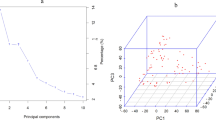Summary
In 1922 Clark, Martin and Ball published descriptions of 207 hexaploid wheat landraces and improved cultivars, collected in the USA: 189 bread wheat accessions (Triticum aestivum), 24 club wheats (T. compactum) and four spelt wheats (T. spelta). After omitting 24 bread wheat accessions with identical descriptions as other accessions, the descriptions were used here to classify the remaining 183 accessions into five clusters on the basis of 10 selected characters. Clusters 1 and 3 include mainly accessions introduced from North and West Europe. These accessions must derive from the European Zeeuwse and Gelderse landrace groups. Hence most of the accessions belonging to these two clusters belong to the North and West European heritage. Cluster 2 includes most of the accesions introduced from Australia and Canada, or belonging to the club wheats. Most accessions from the USSR1 are included in cluster 4. Here we also find Turkey and related landraces. All but one pubescent accessions are included in cluster 5.
The wide variation of US wheats, described in 1922, forms the basis of the Foundation Germplasm wheats as defined by Cox (1991). Apparently no hard white winter wheat landraces and cultivars were described.
Similar content being viewed by others
Abbreviations
- SWS:
-
soft white spring
- SWW:
-
soft white winter
- SRS:
-
soft red spring
- SRW:
-
soft red winter
- HWS:
-
hard white spring
- HRS:
-
hard red spring
- HRW:
-
hard red winter
References
Anonymous, 1987, GENSTAT 5, Reference Manual. Claredon Press, Oxford.
Clark, J.A., 1936. Improvement in wheat. Yearbook of Agriculture-1936, Washington: 207 p.
Clark, J.A., J.H. Martin & R.C. Ball, 1922. Classification of American wheat varieties. USDA bull. 1074. Washington: 238 p.
Clark, J.A., J.H. Martin & C.R. Ball, 1922. Classification of American wheat varieties. USDA bull. 1074. Washington: 238 p.
Cox. T.S., 1991. The contribution of introduced germplasm to the development of U.S. cultivars. In: Use of plant introductions in cultivar development, Part 1. Crop Science Society of America spec. publ. no. 17, p. 25–47.
Cox, T.S., G.L., Lookhart, D.E., Walker, L.G., Harrell, L.D., Albers & D.M., Rodgers, 1985. Genetic relationships among hard red winter wheat cultivars as evaluated by pedigree analysis and gliadin polyacrylamide gel electrophoresis patterns. Crop Sci. 25: 1058–1063.
Harrington, J.B., 1927. A comparative study of strains of Marquis wheat. Scient. Agric. 8: 77–104.
Hintum, Th.J.L. van, 1991. The Core Collection Concept, a key to germplasm collections. Barley Genetics VI, Vol. I. Proceedings of the Sixth International Barley Genetics Symposium (ed. L. Munck). pp. 40–41.
Lehmann-Nitsche, R., 1937. Einzelheiten zur Entdeckungsund Kulturgeschichte des östlichen Südamerikas. I. Der erste Weizenbau (1527), Ibero-Amer. Archiv 9: 80–91.
Murphy, J.P., T.S., Cox & D.M., Rodgers, 1986. Cluster analysis of red winter wheat cultivars based upon coefficients of parentage. Crop Sci. 26: 672–676.
Percival, J., 1921. The wheat plant. A monograph. London: 473 p.
Quisenberry, K.S. & L.P., Reitz, 1974. Turkey wheat: the cornerstone of an empire. Agric. Hist. 48: 98–114.
Salmon, S.C., O.R., Matthew & R.W., Leukel, 1953. A half century of wheat improvement in the United States. Adv. Agron. 5: 3–151.
Zeven, A.C., 1969. Fourth supplementary list of wheat varieties classified according to their genotype for hybrid necrosis. Euphytica 18: 43–57.
Zeven, A.C., 1980. The spread of bread wheat over the Old World since the Neolithicum as indicated by its genotype for hybrid necrosis. Journ. Agric. Trad. & Bot. Appl. 27: 19–53.
Zeven, A.C., 1983. The character brown ear of bread wheat: a review. Euphytica 32: 299–310.
Zeven, A.C., 1986. Landrace groups of bread wheat (Triticum aestivum L. em. Thell.). Acta Horticulturae 182: 365–376.
Zeven, A.C., 1990a. Landraces and improved cultivars of bread wheat and other wheat types grown in the Netherlands up to 1944. Wageningen Agric. Univ. Papers 90.2. Wageningen: 103 pp.
Zeven, A.C., 1990b. Classification of landraces and improved cultivars of rivet wheat (Triticum turgidum) and bread wheat (T. aestivum) from Great Britain and described in 1934. Euphytica 47: 249–258.
Zeven, A.C. & R., Schachl, 1989. Groups of bread wheat landraces in Austrian alps. Euphytica 41: 235–246.
Author information
Authors and Affiliations
Rights and permissions
About this article
Cite this article
Zeven, A.C., van Hintum, T.J.L. Classification of landraces and improved cultivars of hexaploid wheats (Triticum aestivum, T. compactum and T. spelta) grown in the USA and described in 1922. Euphytica 59, 33–47 (1991). https://doi.org/10.1007/BF00025359
Received:
Accepted:
Issue Date:
DOI: https://doi.org/10.1007/BF00025359




